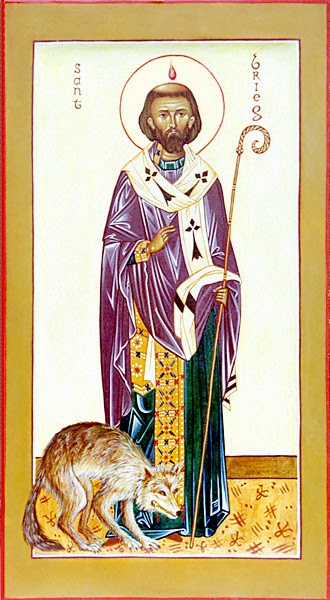 |
| Seven Saints of Brittany |
 |
| ST. CORENTIN |
Only three of these saints are recognized by the Catholic Church: St. Yves (12-13th century); St. Corentin (Bishop of Quimper, 5th century) and St. Clair (the first Bishop of Nantes in the 3rd century).
This is because up to the 10th century there was no specific procedure for canonization and if the Bishop and congregation spontaneously decided to worship a deceased monk or priest, then his relics would be enshrined and he would be made a saint.
The Breton saints belonged in a older era which measured and defined their saintly contributions in a different way, and not simply in terms of martyrdom, miracle-working and spiritual perfection.
Often the Breton 'saints' were the semi-monastic clergy who supervised the migration from Britain to Brittany from the 6th century onwards and served their flock in both spiritual and political roles.
Also, the concept of 'saintliness' has changed.
In the early days of the church sanctus meant to be consecrated by rite and those who had been baptised were 'saints'. In the 4th century onwards Christianity had taken root and the title 'saint' was reserved for the clergy (especially monks) and normally it was honorific. This use of the title 'saint' (which had disappeared elsewhere) was imported into Brittany by migrating Britons and continued until the 7th century.
From the perspective of place names it is difficult to assess whether elements, which appear to be personal names, following a plou, a lan or a tre are, in fact, saints' names. They do not have to be saints' names and may simply be unknown personal names rather than unknown saints.
Over the years there has been a proliferation of myths surrounding 'unknown' saints whose historical existence is very questionable.
 |
| RELICS OF ST YVES |
 |
| RELICS OF ST. MALO |
The Breton saints belonged in a older era which measured and defined their saintly contributions in a different way, and not simply in terms of martyrdom, miracle-working and spiritual perfection.
Often the Breton 'saints' were the semi-monastic clergy who supervised the migration from Britain to Brittany from the 6th century onwards and served their flock in both spiritual and political roles.
Also, the concept of 'saintliness' has changed.
In the early days of the church sanctus meant to be consecrated by rite and those who had been baptised were 'saints'. In the 4th century onwards Christianity had taken root and the title 'saint' was reserved for the clergy (especially monks) and normally it was honorific. This use of the title 'saint' (which had disappeared elsewhere) was imported into Brittany by migrating Britons and continued until the 7th century.
 |
| ST. BRIEUC |
 |
| ST. SAMSON |
 |
| ST. PATERN |
Over the years there has been a proliferation of myths surrounding 'unknown' saints whose historical existence is very questionable.

Comments
Post a Comment